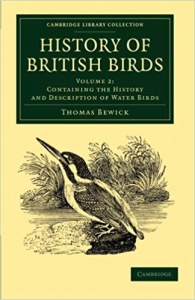| Author | Rita Smith |
| Air Date | 8/23/2007 |

Thomas Bewick Transcript
Thomas Bewick was the finest of all English practicioners of wood engraving and was the first person to make the work of the illustrator as important, in books for children, as the text. Born in 1735, in rural England, Bewick early on showed his skill in draftsmanship by covering the hearthstones of his home with chalk drawings and filling the margins of his school books with penciled sketches. At age 14, he was apprenticed to an engraver in the town of Newcastle and later joined his master as a partner in the business.
Most of the work of the shop was in metal engraving, but occasionally there was work in woodcuts, especially in books for children. Bewick worked primarily in metal at the shop during the day, but he enjoyed working in wood, and spent long evenings at home making woodcuts, perfecting a technique called “white line” engraving, which enabled him to produce sophisticated and delicate pictures on a level that never was exceeded in the woodcut format. His pictures are small images, often only an inch and a half square or two by three inches, but immense detail is packed into them, quite a difference from the relatively crude, simple woodcuts which adorned books for children before Bewick. They delineate rural scenes or animals or birds surrounded by a detailed landscape.
In Jane Eyre, the heroine is reading Bewick’s The History of British Birds. Looking at a scene of a cemetary, she muses, “I can’t tell what sentiment haunted the quiet solitary churchyard with its inscribed headstone; its gate, its two trees, its low horizon, girdled by a broken wall and its newly risen crescent attesting the hour of even-tide.”1 She discovers all that in 5 or 6 square inches. In the introduction to the sixth edition of the book on British birds, Bewick tells what motivated him: “When I first undertook my labours in Natural History,” he writes, “my strongest motive was to lead the minds of youth to the study of that delightful pursuit. . . . and the more readily to allure their . . . attention to the Great Truths of Creation, I illustrated them . . . with all the fidelity and animation I was able to impart.”2 Each small picture told an entire story, in perfect undeviating accuracy bringing, I imagine, hours of enjoyment and creativity to children pouring over the detailed vignettes and imagining the stories the pictures inspired.
Notes:
1 Quoted in Humphrey, p. 59.
2 Quoted in Bain’s “Introduction” to Thomas Bewick Vignettes, p. 5
Sources:
Bewick, Thomas, A Memoir of Thomas Bewick, written by himself. Ian Bain, ed. London: Oxford University Press, 1984.
Carpenter, Humphrey and Mari Prichard, eds. The Oxford Companion to Children’s Literature. Oxford: Oxford University Press, 1984.
Thomas Bewick Vignettes, being tail-pieces engraved principally for his General History of Quadrupeds & History of British Birds. Ian Bain, ed. London: The Scholar Press, 1978.